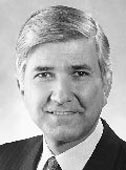Creativity in Medicine
What defines creativity? Where does creativity come from? Where does it exist in
medicine?

Tirone David
|
We were privileged to have someone who has been described as a creative genius enlighten
us about these questions at a recent Surgical Services Rounds at the University
Health Network. Dr. Tirone David, University Professor and Melanie Munk Chair of
Cardiovascular Surgery at the Peter Munk Cardiac Centre, shared his unique insight
on "Creativity in Medicine" to a rapt audience. Dr. David's long history of technical
and conceptual creativity in cardiac surgery has had a profound impact around the
world -- from introducing Gortex chordae tendinae in mitral valve reconstruction,
to inventing new types of heart valves and a valve sparing procedure, to his infarct
exclusion operation.
Creativity, according to Dr. David, involves two fundamental qualities. The first
relates to genius theory, some innate quality in an individual that portends an
intrinsic skill in a particular area. As an example, Dr. David cited Albert Einstein
as a widely recognized archetype of genius. Interestingly, following Einstein's
death, an examination of his brain revealed unique structural features that may
explain his innate "genius". The second quality that defines creativity is the stepwise,
logical evolution of ideas, products, techniques, and in the case of surgery, operative
procedures that follows from the work of thoughtful and skillful individuals.
Was the discovery of the structure of DNA by Watson and Crick an example of creative
inspiration? No. Dr. David used this discovery to illustrate creativity as a logical
stepwise progression of ideas from individual to individual.
|
Starting from Oswald
Avery's 1935 discovery that DNA is the material of which genes and chromosomes are
made, to Chargaff 's discovery in 1950 that in natural DNA the number of guanine
units equals the number of cytosine units and the number of adenine units equals
the number of thymine units, to Linus Pauling's 1951 discovery of the alpha helical
structure in proteins, Dr. David illustrated the logical progression of ideas that
culminated in the next step: the discovery of the helical structure of DNA by Watson,
Crick, Wilkins and Franklin in 1953. This sequence of events over decades serves
as an example of Edison's description of creativity as 1% inspiration and 99% perspiration!
What describes creative individuals? They are skillful, self-motivated and knowledgeable,
but those qualities alone are not sufficient. Creativity is something that not only
has a flow, but is also judged within a domain, by a field of assessors, judges
and peers who determine if an individual has demonstrated creativity. This process
of judging creativity and discovery is clearly defined in medicine. The Nobel Prize
winning discovery of Helicobacter pylori by Marshall and Warren aptly illustrates
this process. In 1984, when Robin Warren observed small helical bacteria colonizing
the antrum of the stomach in patients from which biopsies had been taken and signs
of inflammation that were always present in the gastric mucosa close to where the
bacteria were seen, he concluded that gastritis is a "bacterial disease". His peers
did not believe him. However, when Barry Marshall, a young clinical fellow, became
interested in Warren's findings and conducted a study including 100 patient biopsies
with Warren, the findings were verified and finally judged by their peers to be
a novel discovery that revolutionized treatment of peptic ulcer disease.
Creativity in medicine unfolds over time, a lifetime in most cases. Dr. David describes
it as the synergy of many sources and not a product of a single mind. Why not? Because
one cannot be knowledgeable in everything... Creative ideas are generated from the
previous knowledge and experience of others and thus, creativity is in continuity
with the past. Dr. David's passion for creativity is inspiring, as were his insights
on creativity in medicine. We are privileged to have his creative genius amongst
us at the university.
Mitesh Badiwala
Cardiac Surgery Resident
|